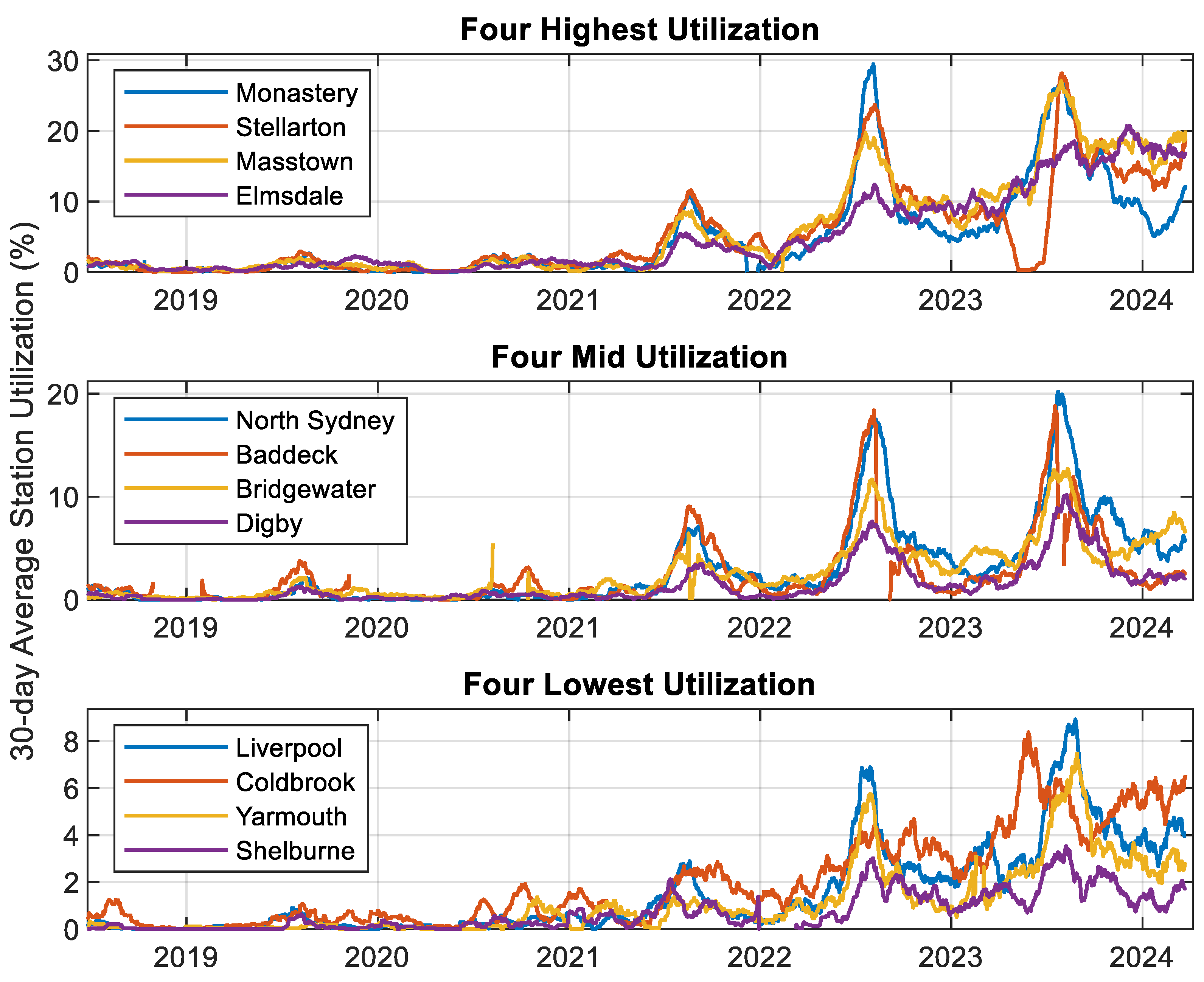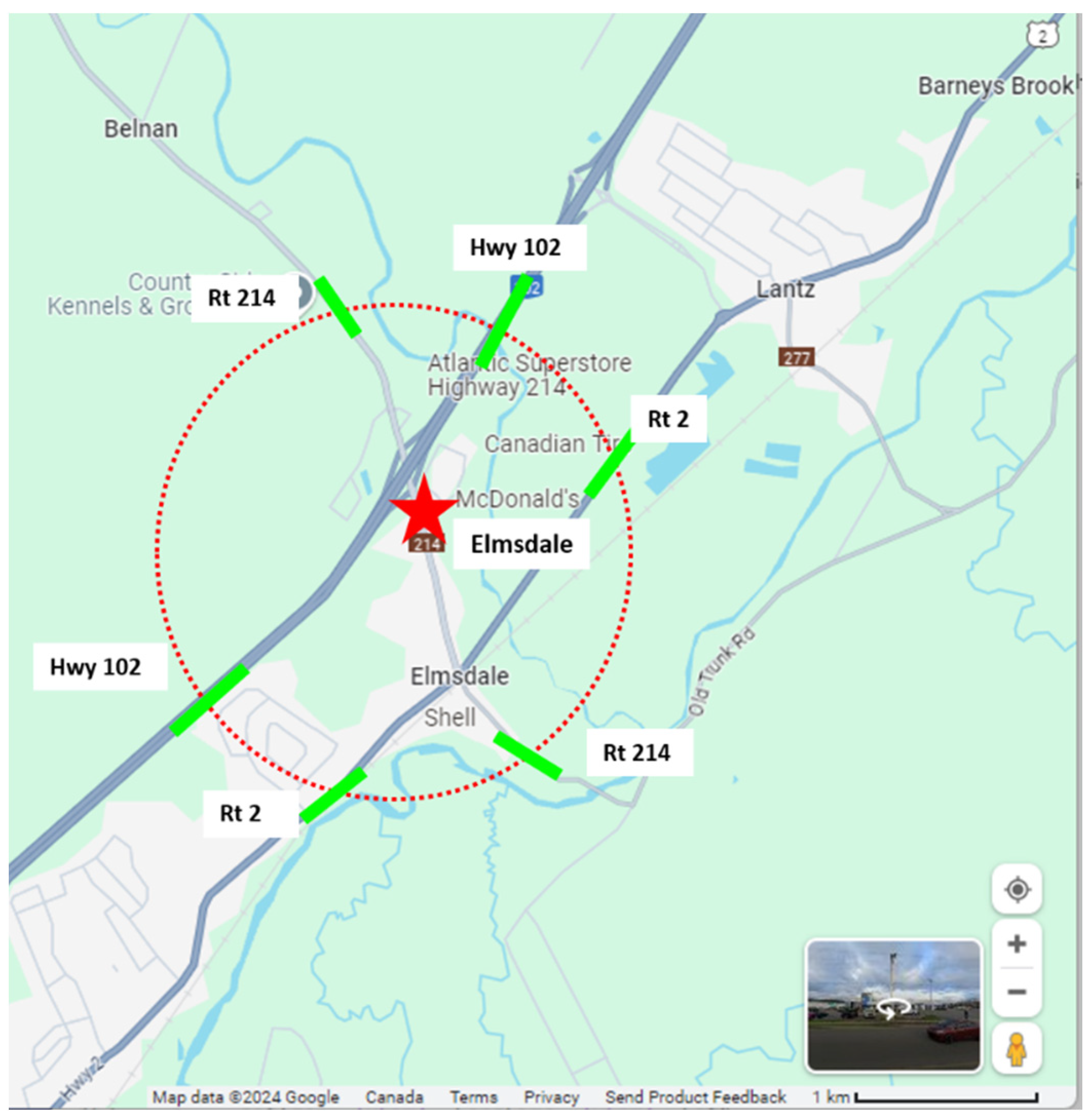Geographic Factors Impacting the Demand for Public EV Charging: An Observational Study
Abstract
:1. Introduction
1.1. Literature Review
- Reducing the chances of EV drivers finding all cordsets in use and having to debate whether another nearby site will have better availability
- Reducing maximum wait times since everyone is in a common queue
- Improving site reliability, since even if one charger is inoperable, others in the same hub will likely still work. Private network operators have a lackluster record of site maintenance [13].
- A large charging hub, where several or many EV drivers must spend tens of minutes, may nucleate a small commercial zone, with benefits accruing to both the drivers waiting there in the form of added amenities and the local economy.
- In the construction phase, economies of scale such as ‘soft costs’ like permitting and ‘hard costs’ such as trenching and pouring transformer pad mounts mean that charging hubs should realize lower per-cordset costs than dispersed sites [14].
- In operation, having multiple units of a given hardware reduces the burden of training a maintenance workforce to individual models and keeping spare parts.
1.2. Structure of This Study
1.3. Context of the Analysis
2. Data and Methods
2.1. Charging Event Data
- (1)
- Identifying and deleting duplicate events.
- (2)
- Aggregating sequential charging events when the same user ID initiated charging at the same location multiple times separated by less than 20 min, if no other user initiated a charging event between two such events.
- (3)
- Deleting charging events that, after aggregation, indicated less than 0.5 kWh of energy was transferred.
2.2. Traffic Volumes
2.3. Local Population
2.4. Competition
2.5. Interprovincial Highway
3. Regression Method and Results
3.1. Linear Regression
3.2. Fitting Parameters
3.3. Normalized Value Analysis
4. Discussion of Key Results
5. Conclusions and Policy Implications
Author Contributions
Funding
Data Availability Statement
Conflicts of Interest
References
- International Energy Agency. Global EV Outlook 2024; Moving Towards Increased Affordability. International Energy Agency: Paris, France, April 2024; Available online: https://iea.blob.core.windows.net/assets/a9e3544b-0b12-4e15-b407-65f5c8ce1b5f/GlobalEVOutlook2024.pdf (accessed on 9 July 2024).
- Levy, J.; Riu, I.; Zoi, C. The Costs of EV Fast Charging Infrastructure and Economic Benefits to Rapid Scale-Up. EVgo Fast Charging. May 2020. Available online: https://a.storyblok.com/f/78437/x/f28386ed92/2020-05-18_evgo-whitepaper_dcfc-cost-and-policy.pdf (accessed on 9 July 2024).
- Bunce, L.; Harris, M.; Burgess, M. Charge up then charge out? Drivers’ perceptions and experiences of electric vehicles in the UK. Transp. Res. Part A Policy Pract. 2014, 59, 278–287. [Google Scholar] [CrossRef]
- Wood, E.; Rames, C.; Muratori, M.; Raghavan, S.; Melaina, M. National Plug-In Electric Vehicle Infrastructure Analysis. USA Dept Energy 2017, 1393792. [Google Scholar] [CrossRef]
- Baresch, M.; Moser, S. Allocation of e-car charging: Assessing the utilization of charging infrastructures by location. Transp. Res. Part A Policy Pract. 2019, 124, 388–395. [Google Scholar] [CrossRef]
- Bräunl, T.; Harries, D.; McHenry, M.; Wager, G. Determining the optimal electric vehicle DC-charging infrastructure for Western Australia. Transp. Res. Part D Transp. Environ. 2020, 84, 102250. [Google Scholar] [CrossRef]
- Schulz, F.; Rode, J. Public charging infrastructure and electric vehicles in Norway. Energy Policy 2022, 160, 112660. [Google Scholar] [CrossRef]
- MacKenzie, D.; Jabbari, P.; Khaloei, M. Locating Fast Charging Stations for Safe and Reliable Intercity Electric Vehicle Travel in Washington; Pacific Northwest Transportation Consortium: Washington, WA, USA, 2018. [Google Scholar]
- Illmann, U.; Kluge, J. Public charging infrastructure and the market diffusion of electric vehicles. Transp. Res. Part D Transp. Environ. 2020, 86, 102413. [Google Scholar] [CrossRef]
- Miele, A.; Axsen, J.; Wolinetz, M.; Maine, E.; Long, Z. The role of charging and refuelling infrastructure in supporting zero-emission vehicle sales. Transp. Res. Part D Transp. Environ. 2020, 81, 102275. [Google Scholar] [CrossRef]
- U.S. Department of Transportation. Biden-Harris Administration Takes Key Step Forward in Building a National Network of User-Friendly, Reliable, and Ac-cessible Electric Vehicle Chargers|US Department of Transportation. US-DOT. June 2022. Available online: https://www.transportation.gov/briefing-room/biden-harris-administration-takes-key-step-forward-building-national-network-user (accessed on 27 September 2024).
- Pearre, N.S.; Swan, L.G. Observational Evaluation of the Maximum Practical Utilization of Electric Vehicle DCFC Infrastructure. World Electr. Veh. J. 2022, 13, 190. [Google Scholar] [CrossRef]
- Rempel, D.; Cullen, C.; Bryan, M.M.; Cezar, G.V. Reliability of Open Public Electric Vehicle Direct Current Fast Chargers. Hum. Factors 2023, 66, 2528–2538. [Google Scholar] [CrossRef]
- Nelder, C.; Rogers, E. Reducing EV Charging Infrastructure Costs. Rocky Mt. Inst. 2019, 48. [Google Scholar] [CrossRef]
- Tesla. Find Us|Tesla. Available online: https://www.tesla.com/en_ca/findus? (accessed on 27 September 2024).
- Wu, Y.; Ribberink, H. Methodology to Estimate the Need for Direct-Current Fast-Charging Stations along Highways in Canada. J. Transp. Eng. Part A Syst. 2020, 146, 04020108. [Google Scholar] [CrossRef]
- Pearre, N.S.; Swan, L.G.; Burbidge, E.; Balloch, S.; Horrocks, L.; Piper, B.; Anctil, J. Regional Electric Vehicle Fast Charging Network Design Using Common Public Data. World Electr. Veh. J. 2022, 13, 212. [Google Scholar] [CrossRef]
- He, Y.; Kockelman, K.M.; Perrine, K.A. Optimal locations of U.S. fast charging stations for long-distance trip completion by battery electric vehicles. J. Clean. Prod. 2019, 214, 452–461. [Google Scholar] [CrossRef]
- Khan, H.O.A.; Saeed, F.; Arshad, N. Propelling the Penetration of Electric Vehicles in Pakistan by Optimal Placement of Charging Stations. Eng. Proc. 2021, 11, 34. [Google Scholar] [CrossRef]
- Nie, Y.M.; Ghamami, M. A corridor-centric approach to planning electric vehicle charging infrastructure. Transp. Res. Part B Methodol. 2013, 57, 172–190. [Google Scholar] [CrossRef]
- Luo, Q.; Tian, W.; Jia, H. Location and Capacity Model of Charging Station for Electric Vehicles Based on Commuting Demand. IEEJ Trans. Electr. Electron. Eng. 2020, 15, 1089–1099. [Google Scholar] [CrossRef]
- Csonka, B.; Csiszár, C. Determination of charging infrastructure location for electric vehicles. Transp. Res. Procedia 2017, 27, 768–775. [Google Scholar] [CrossRef]
- Bundale, B.M. Nova Scotia Power to Build Electric Vehicle Fast-Charging Network in Province. CityNews Halifax, Halifax. 6 March 2018. Available online: https://halifax.citynews.ca/2018/03/06/nova-scotia-power-to-build-electric-vehicle-fast-charging-network-in-province/ (accessed on 19 July 2024).
- Nova Scotia. Traffic Volumes—Provincial Highway System. Nova Scotia Open Data. Available online: https://data.novascotia.ca/Roads-Driving-and-Transport/Traffic-Volumes-Provincial-Highway-System/8524-ec3n (accessed on 27 September 2024).
- Google. Google Maps. Available online: https://www.google.com/maps (accessed on 24 July 2024).
- Statistics Canada. Canada’s National Statistical Agency. Available online: https://www.statcan.gc.ca/en/start (accessed on 22 July 2024).
- Wikipedia. The Free Encyclopedia. Available online: https://www.wikipedia.org/ (accessed on 22 July 2024).
- AreaVibes. Best Places to Live in the US & Canada. Available online: https://www.areavibes.com/ (accessed on 22 July 2024).
- Webb, M. Charging Electric Vehicles: Developing Policy Options to Accommodate the at Home Charging of Garage Orphan Electric Vehicles in the Metro Vancouver Region. Available online: https://open.library.ubc.ca/soa/cIRcle/collections/undergraduateresearch/52966/items/1.0300459 (accessed on 19 July 2024).
- Tesla. Opening the North American Charging Standard|Tesla Canada. Available online: https://www.tesla.com/en_ca/blog/opening-north-american-charging-standard (accessed on 27 August 2024).
- Electric Vehicle Registration Data | Open Data|Nova Scotia. Available online: https://data.novascotia.ca/Permits-and-Licensing/Electric-Vehicle-Registration-Data/avxy-ifhs/about_data (accessed on 27 August 2024).
- Ledna, C.; Muratori, M.; Brooker, A.; Wood, E.; Greene, D. How to support EV adoption: Tradeoffs between charging infrastructure investments and vehicle subsidies in California. Energy Policy 2022, 165, 112931. [Google Scholar] [CrossRef]
- Greene, D.L.; Muratori, M.; Kontou, E.; Borlaug, B.; Melaina, M.; Brooker, A. Quantifying the Tangible Value of Public Electric Vehicle Charging Infrastructure; NREL/TP-5400-70340; California Energy Commission: Sacramento, CA, USA, 2020. [Google Scholar] [CrossRef]






| Location | Traffic Volume | Population | Competition | InterProv Highway | Observed Events/y | Predicted Events/y |
| (units) | (kADT) | (1000s) | (kW min2) | (/) | (count) | (count) |
| Baddeck | 5.3 | 0.80 | 0 | 0.5 | 1027 | 860 |
| Bridgewater | 31.9 | 10.6 | 0.50 | 0 | 1084 | 1170 |
| Coldbrook | 36.0 | 14.4 | 8.32 | 0 | 860 | 743 |
| Digby | 6.6 | 2.0 | 0 | 0 | 546 | 248 |
| Elmsdale | 42.1 | 4.4 | 5.64 | 1.0 | 2250 | 2420 |
| Liverpool | 8.0 | 3.4 | 0 | 0 | 626 | 309 |
| Masstown | 36.1 | 13.0 | 0.35 | 1.0 | 2753 | 2682 |
| Monastery | 14.0 | 0.0 | 0 | 1.0 | 1964 | 1828 |
| North Sydney | 7.5 | 5.7 | 0 | 0.5 | 1002 | 978 |
| Shelburne | 5.5 | 4.3 | 0 | 0 | 299 | 228 |
| Stellarton | 25.2 | 18.7 | 0 | 1.0 | 2237 | 2370 |
| Yarmouth | 13.9 | 7.2 | 0 | 0 | 445 | 546 |
| Variable | (units) | Lower | Best a | Upper |
| Traffic, a1 | (Events/kADT) | 17 | 35 | 53 |
| Population, a2 | (Events/kPop) | −23 | 8 | 39 |
| Competition, a3 | (Events/Comp) | −152 | −77 | −2 |
| InterProv, a4 | (Events/InterProv) | 980 | 1335 | 1690 |
| Variable | (units) | Lower | Best | Upper |
| Traffic | (%/%) | 0.226 | 0.445 | 0.664 |
| Population | (%/%) | −0.114 | 0.015 | 0.143 |
| Competition | (%/%) | −0.116 | −0.062 | −0.008 |
| InterProv | (%/%) | 0.343 | 0.428 | 0.514 |
Disclaimer/Publisher’s Note: The statements, opinions and data contained in all publications are solely those of the individual author(s) and contributor(s) and not of MDPI and/or the editor(s). MDPI and/or the editor(s) disclaim responsibility for any injury to people or property resulting from any ideas, methods, instructions or products referred to in the content. |
© 2024 by the authors. Published by MDPI on behalf of the World Electric Vehicle Association. Licensee MDPI, Basel, Switzerland. This article is an open access article distributed under the terms and conditions of the Creative Commons Attribution (CC BY) license (https://creativecommons.org/licenses/by/4.0/).
Share and Cite
Jayanath, N.; Pearre, N.S.; Swan, L.G. Geographic Factors Impacting the Demand for Public EV Charging: An Observational Study. World Electr. Veh. J. 2024, 15, 445. https://doi.org/10.3390/wevj15100445
Jayanath N, Pearre NS, Swan LG. Geographic Factors Impacting the Demand for Public EV Charging: An Observational Study. World Electric Vehicle Journal. 2024; 15(10):445. https://doi.org/10.3390/wevj15100445
Chicago/Turabian StyleJayanath, Niranjan, Nathaniel S. Pearre, and Lukas G. Swan. 2024. "Geographic Factors Impacting the Demand for Public EV Charging: An Observational Study" World Electric Vehicle Journal 15, no. 10: 445. https://doi.org/10.3390/wevj15100445





